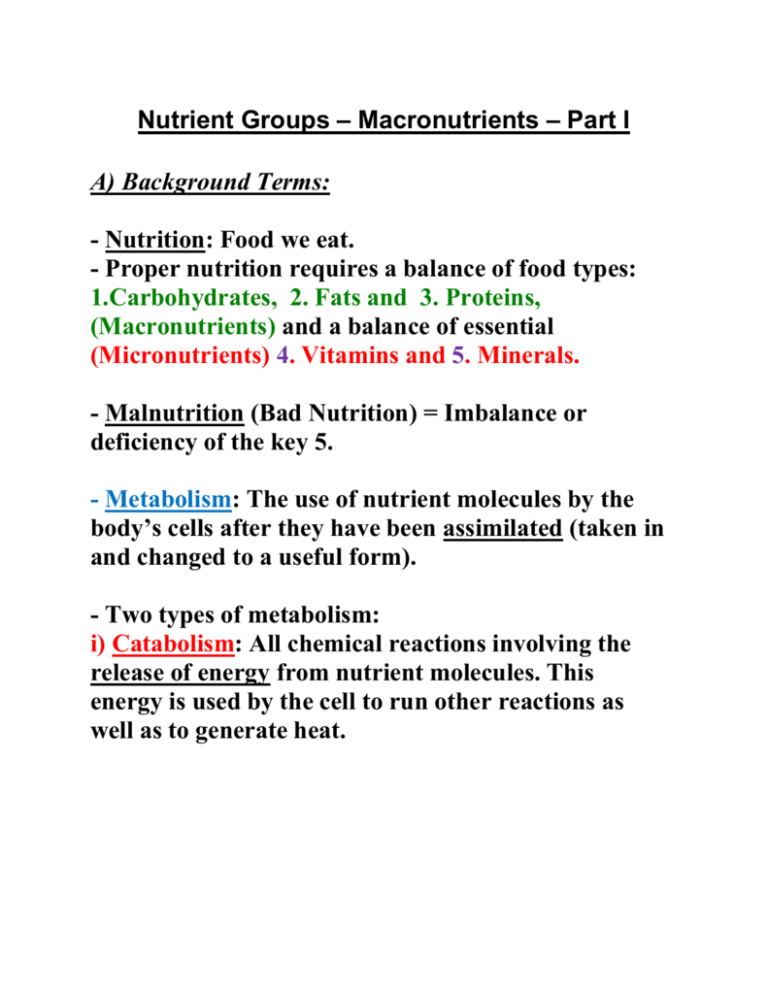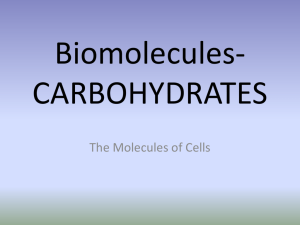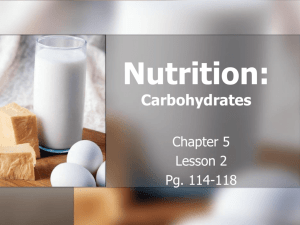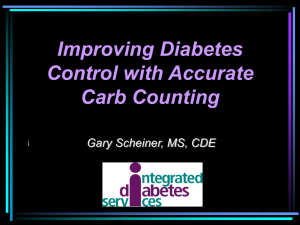Nutrient Groups – Macronutrients – Part I - Mr. Lesiuk
advertisement

Nutrient Groups – Macronutrients – Part I A) Background Terms: - Nutrition: Food we eat. - Proper nutrition requires a balance of food types: 1.Carbohydrates, 2. Fats and 3. Proteins, (Macronutrients) and a balance of essential (Micronutrients) 4. Vitamins and 5. Minerals. - Malnutrition (Bad Nutrition) = Imbalance or deficiency of the key 5. - Metabolism: The use of nutrient molecules by the body’s cells after they have been assimilated (taken in and changed to a useful form). - Two types of metabolism: i) Catabolism: All chemical reactions involving the release of energy from nutrient molecules. This energy is used by the cell to run other reactions as well as to generate heat. ii) Anabolism: All chemical reactions that involve nutrient molecules to build chemical compounds used for structural purposes. - Catabolism + Anabolism = Total Metabolism. B) Carbohydrate Metabolism: - After carbohydrates are digested they are broken down into simple sugars. Human cells preferably catabolize a simple sugar called glucose (glucose is used to release energy 4.1 Kcal/g). - Most of the energy released during the catabolism of glucose goes into the production of a molecule called Adenosine Triphosphate (ATP). The rest of the energy released is given off as heat. - The energy temporarily stored in each ATP molecule can be released to run other cellular reactions and processes. See Animation: Not Great, but check it out. http://www.youtube.com/watch?v=bbtqF9q_pFw - Only enough ATP for immediate cellular requirements is made at any one time. Any excess glucose that is not needed is anabolized (used for building) into larger molecules (glycogen) that will be stored for later use. - The two homeostatic processes above maintain a consistent blood glucose concentration (0.1%) : 80 120 mg of glucose/100ml of blood. - The hormone Insulin (produced by the pancreas) allows cells to take up excess glucose from the blood. Insulin deficiency results in “Hyperglycemia”. - Many hormones, including Glucagon (produced by the pancreas as well), result in “Glycogenolysis” to raise blood glucose concentration. - “Carbo-Loading”: Endurance athletes that must occasionally sustain long periods of exercise, will prepare for the event in the following way: Step 1. About a week before the event, adjust your carbohydrate intake, if needed, so that it's about 50 to 55 percent of your total calories. Increase protein and fat intake to compensate for any decrease in carbohydrates. Continue training at your normal level. This helps deplete your carbohydrate stores and make room for the loading that comes next. Step 2. Three to four days before the event, increase your carbohydrate intake to about 70 percent of your daily calories. Smaller athletes should consume about 4.5 grams of carbs per pound (kilogram) of body weight, while larger athletes should consume about 3.5 grams per pound of body weight to get adequate carbohydrate intake. Cut back on foods higher in fat to compensate for the extra carbohydrate-rich foods. Also scale back your training to avoid using the energy you're trying to store up. Rest completely the day before your big event. - Muscles can then sustain aerobic exercise up to 50% longer than usual. - If the body has an excess of glucose, and all of the glycogen stores (liver and muscles) are full, the surplus glucose is converted to fat by the liver and stored as adipose tissue (body fat) around the body. GLUCOSE GLYCOGEN FAT Unrefined and Refined Carbs – Glycemic Index (G.I.) The main reason why carbs have such a bad reputation is due to the fact that western cultures have had a love affair with REFINED carbs – Carbs that have a very High Glycemic Index. These high GI Carbs, spike your blood sugar very quickly. Refined carbohydrates refers to foods where machinery has been used to remove the high fiber bits (the bran and the germ) from the grain. White rice, white bread, sugary cereals, and pasta and noodles made from white flour are all examples of refined carbohydrates. These “hyperglycemic carbs” tend to cause a “Blood Sugar Tsunami”, which cause the body to spike levels of Insulin. A diet high in hyperglycemic carbs causes cells to become resistant to insulin. Glucose is not efficiently taken up by muscle and liver cells and as a result the body’s blood glucose levels can no longer be properly maintained TYPE II Diabetes. The other problem with High GI Carbs, is that when a large surge of Insulin is put out, we end up feeling very hungry afterward. We also have an energy crash. This often leads to over-eating. A third problem is that the Insulin itself has been found to have an inflammatory effect on our blood vessels. This has recently been linked to cardiovascular diseases such as, atherosclerosis and strokes. Recent studies show a link between high insulin levels and some forms of cancer. UNREFINED carbohydrates still contain the whole grain, including the bran and the germ, so they're higher in fiber and will keep you feeling fuller for longer - great if you're trying to lose weight and hate feeling hungry. They have lower GI numbers, which means the sugars are digested and absorbed more slowly into the blood stream. Examples include wholegrain rice, whole-meal bread, porridge oats and whole wheat pasta.






